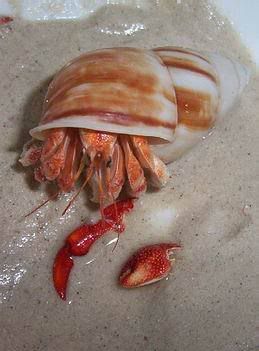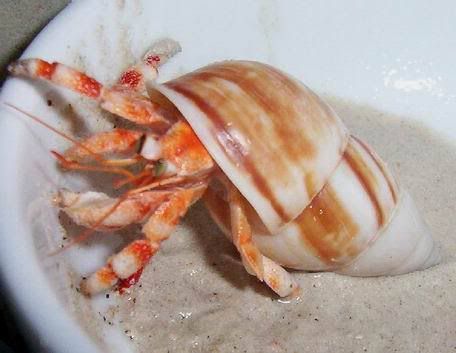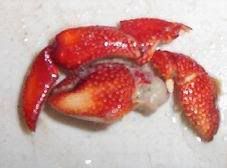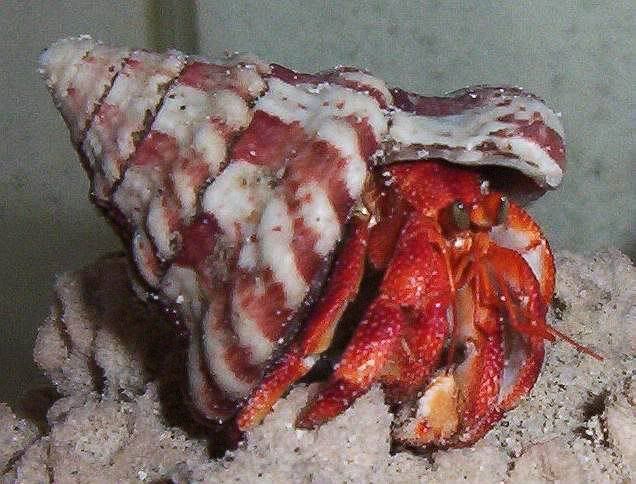[Species] C.preudorugosus is Actually C.perlatus
-
Mokulele_Hawai'i
Topic author - Posts: 142
- Joined: Sat Mar 05, 2005 3:31 pm
- Location: Jakarta, Indonesia
- Contact:
[Species] C.preudorugosus is Actually C.perlatus
Referring to this page:
http://www.tonycoenobita.com/species_ps ... s_eng2.htm
and my experience handling various appearances of C.perlatus ( strawberry l h c), I'm currently convinced that the Japanese scientist did not find a new species in the Philippines. The one called "akashiki-oka yadokari" ( sunrise land hermit crab ) is actually a C.perlatus species, but in the homeland of such pale-colored hermit crabs, there are lack of carotene-enriched food.
http://www.tonycoenobita.com/species_ps ... s_eng2.htm
and my experience handling various appearances of C.perlatus ( strawberry l h c), I'm currently convinced that the Japanese scientist did not find a new species in the Philippines. The one called "akashiki-oka yadokari" ( sunrise land hermit crab ) is actually a C.perlatus species, but in the homeland of such pale-colored hermit crabs, there are lack of carotene-enriched food.
Hermit crab lover since 1981
Founder of "Blueberry land hermit crab" - common name for Coenobita purpureus, and "Zebra Sunset land hermit crab" for a new subspecies of Coenobita violascens
Founder of "Blueberry land hermit crab" - common name for Coenobita purpureus, and "Zebra Sunset land hermit crab" for a new subspecies of Coenobita violascens
-
Guest
-
MudCrabDude
Annopia would definitely concur:Silent Protagonist wrote:...even in captivity perlatus will gradually lose there red if they are not fed carotene enriched foods often...
viewtopic.php?t=50117
-
Mokulele_Hawai'i
Topic author - Posts: 142
- Joined: Sat Mar 05, 2005 3:31 pm
- Location: Jakarta, Indonesia
- Contact:
Another Proof that Strawberries Can Change Body Color
Abaiang, one of my strawberries, who chooses sinistral land snail shell instead of his former topshell, has recently molted and lost his solid red tone:


This is Abaiang's uneaten exoskeleton - a proof that he was solid red:

A picture of Abaiang taken several months ago:



This is Abaiang's uneaten exoskeleton - a proof that he was solid red:

A picture of Abaiang taken several months ago:

Hermit crab lover since 1981
Founder of "Blueberry land hermit crab" - common name for Coenobita purpureus, and "Zebra Sunset land hermit crab" for a new subspecies of Coenobita violascens
Founder of "Blueberry land hermit crab" - common name for Coenobita purpureus, and "Zebra Sunset land hermit crab" for a new subspecies of Coenobita violascens
-
brad873
-
Guest
Well, one of the things the Coenobita Research Society members have constantly tried to drill into us is that it shouldn't be possible to cross hermit crab species. What you have with a cross is either members of the same species or very closely related ones interbreeding. For example, every single dog you have ever seen is of the species Canis Lupus Familiaris, whether it be a great dane or a chihuahua. While it isn't physically practical to breed these two dogs together, it is still physically possible to create viable embryos.
Hermit crab species should not be this closely related, they're very ancient when compared to dogs or other mammal species. For instance, look at the distribution of C. Clypeatus. This species lives only in the Western Atlantic/Caribbean area. Why? Toward the end of the last ice age the isthmus of Panama arose connecting North and South America, (and spelling the end of birds the size of trucks in S. America). When it arose, it also cut off the Gulf region from the rest of the areas Hermit Crabs have colonized. You basically had a whole area of the globe reconfiguring ocean currents and isolating hermit zoea here, leading to C. Clypeatus evolving in a vacuum for the last 3 million years. Which is why, though I respect Dawn, I disagree with her on whether Strawberries can successfully breed with PPs.
A lot can happen to a species in 3 million years, some of these hermit species may be older than that. While they may be around on the same island as another species, it's really unlikely that they'll cross with one another. It would almost be like you trying to cross yourself with a chimpanzee. You both share a mountain of DNA in common, (over 90%), but the differences you do have are great enough that you can't produce offspring.
Maybe it is a new species, and maybe it's a straw with carotene deficiency. Perhaps it's a new species evolved from straws with carotene deficiencies. It is, however, most definitely not a cross between two species.
Hermit crab species should not be this closely related, they're very ancient when compared to dogs or other mammal species. For instance, look at the distribution of C. Clypeatus. This species lives only in the Western Atlantic/Caribbean area. Why? Toward the end of the last ice age the isthmus of Panama arose connecting North and South America, (and spelling the end of birds the size of trucks in S. America). When it arose, it also cut off the Gulf region from the rest of the areas Hermit Crabs have colonized. You basically had a whole area of the globe reconfiguring ocean currents and isolating hermit zoea here, leading to C. Clypeatus evolving in a vacuum for the last 3 million years. Which is why, though I respect Dawn, I disagree with her on whether Strawberries can successfully breed with PPs.
A lot can happen to a species in 3 million years, some of these hermit species may be older than that. While they may be around on the same island as another species, it's really unlikely that they'll cross with one another. It would almost be like you trying to cross yourself with a chimpanzee. You both share a mountain of DNA in common, (over 90%), but the differences you do have are great enough that you can't produce offspring.
Maybe it is a new species, and maybe it's a straw with carotene deficiency. Perhaps it's a new species evolved from straws with carotene deficiencies. It is, however, most definitely not a cross between two species.
-
brad873
they all started from a single group. there dna is very similare, maybe enough to breed. it is not impossible to breed at all. and there have been human hybids before now, crazy experiments by scientists. i belive a human, cow cross has just been cfreated, even though the embrio is destroyed within 40 days. maybe these crabs are straws or ruggies that evolved into a new type of crab. a ruggie may come from and E, or an indo from a PP. if you say it is impossible to breed, then think that it is not impossible to evolve
-
Guest
-
Guest
Not entirely... the species name for wolf is Canis Lupus, it's the main species line. Dog or Canis Lupus Familiaris is a subspecies of the main line. A relatively young subspecies in fact. There have only been dogs on Earth for a relatively short period of time after the emergence of Homo Sapien Sapien, i.e. you. As such, dogs and wolves share much of the same DNA. More of it in common than humans and chimps, which was the analogy I was making.harles2000 wrote:BDog - there is a small flaw to your dog analogy.
Dogs can breed with both wolves and jackals - neither of which is Canis Familiaris. If I'm not mistaken they can also breed with Dingoes.
Here's a link to wikipedia's article on the Canidae family so you can see what I mean.
Everything you've listed as interbreeding is very closely related to one another. They are also, (and here's the part I think you may have missed from my argument), relatively young species. I mean less than 1-2 million years old.
Here's a link to the Gray Wolf species where you can see that at least the Asian Lineage is around 800,000 years old.
The point I'm trying to make is not that animal A is not able to breed with animal B simply because it's a different species in the same genus. The point I was making was that hermit crab species A and B haven't been exchanging genetic information for several dozens of million years. In that time, the genes that comprise each species have changed enough that they shouldn't be able to combine to create a naturally occurring hybrid. Wolves, Dogs, and Coyotes aren't fantastically old when compared to hermit crabs, and they've been exchanging genes infrequently since then. So, yes, they can cross. The hermit crab family, on the other hand, is older than dirt. In the time since dirt has formed, they've evolved all kinds of different genes, and different numbers of them. This last part is the important one. In order for genes to transcribe, you not only have to have genes for the same component, but they have to be located in roughly the same part of the chromosome and in the same numbered sequence.
For instance, sheep and humans are both mammals, they both have the same number of limbs, eyes, ears, etc. We however, cannot interbreed naturally. The reason for this is that I have different numbers of genes forming a human liver than the sheep has to form its liver. Some of these genes are important, and some of them evolved as transcription errors and are basically junk. The problem is that if I take the genes for my liver and try to give half of them to a sheep, which has a different number, every other gene in there is similarly offset. This offset is such that the part of the human genome for an arm I'm trying to combine with a sheep will end up hitting the part of the sheep genome for a nose, and thus not combine correctly. Rather than cross to create some sort of creature with an arm/nose, it just aborts the embryo and starts over. The numbers have to align closely, or else you get nothing. This is the reason that the back countries of the Western US, Australia and New Zealand are not filled with sheepmen.
How do I get animals with human organs for transplants, then? Easy, you cheat. Let's say I know for a fact which genes make up a sheep's liver and which genes make up a human's. In a fertilized egg cell, both of the chromosomes containing these genes are large enough that I can play "cut and paste" with them. So, basically, I extract the entire gene sequence for a human liver, (instead of just half as I'd get in the case of normal breeding). Then, I knock out completely every single gene for a liver in the sheep chromosome. I finally insert the genes for a human liver in this newly created gap and allow the sheep egg to gestate as normal. Voila, one sheep with a transplantable human liver. Why wouldn't this work normally? Because the numbers wouldn't add up closely enough to create the match you need for a hybrid. This is the difference several million years makes.
Hermit crab species are millions of years old. Old enough that the gene numbers for C. Clypeatus and C. Perlatus shouldn't line up anymore. There's enough differentiation and transcription errors in those several million years between when they last met naturally, that the half of crab A's code no longer lines up closely enough with the half of crab B's code to create offspring. They might as well be written in different languages. By comparison: dogs, wolves and coyotes have less than a million years of separation. The numbers in their codes still line up closely enough to create a match.
Also, that dog/lion thing? I'm calling B.S. on that. The families Canidae and Felidae are different enough I know that isn't possible. Whoever told you that was full of it.
-
Guest
LOL Troppo, nice pomeranian!
I'd like to just remind people to keep it clean and friendly as well.
Also while I do agree that crossbreeding in the wild is unlikely, just as it is unlikely to find crossbred map/painted turtles in the wild, even though they live in the same areas and CAN interbreed they don't, same with many species of birds, that in captivity have been shown to interbreed but don't. The reason for lack of cross-species breeding is generally because animals are "hard wired" to recognise their own species, generally speaking hybrids when they are viable are also infertile, in an evolutionary sense, such hybridization on the part of the parents is a waste of energy because their genetic lines would cease with that next cross bred generation (if the parents no longer bred after this, which is the assumption in basic evolutionary theory). To prevent such useless breedings animals thus have methods such as pheremones, visual cues and other sensory perceptions to tell them who it appropriate to breed with. Sometimes it's as simple as one species all getting into breeding mode at a time that is different than other related species.
This is not to say that interspecies couldnt' occur in captivity, abnormal environment, but this is the reason that you don't often see cross bred animals in the wild. As far as genetic relatedness and family separation I'd have to see some scientific references to comment.
I'd like to just remind people to keep it clean and friendly as well.
Also while I do agree that crossbreeding in the wild is unlikely, just as it is unlikely to find crossbred map/painted turtles in the wild, even though they live in the same areas and CAN interbreed they don't, same with many species of birds, that in captivity have been shown to interbreed but don't. The reason for lack of cross-species breeding is generally because animals are "hard wired" to recognise their own species, generally speaking hybrids when they are viable are also infertile, in an evolutionary sense, such hybridization on the part of the parents is a waste of energy because their genetic lines would cease with that next cross bred generation (if the parents no longer bred after this, which is the assumption in basic evolutionary theory). To prevent such useless breedings animals thus have methods such as pheremones, visual cues and other sensory perceptions to tell them who it appropriate to breed with. Sometimes it's as simple as one species all getting into breeding mode at a time that is different than other related species.
This is not to say that interspecies couldnt' occur in captivity, abnormal environment, but this is the reason that you don't often see cross bred animals in the wild. As far as genetic relatedness and family separation I'd have to see some scientific references to comment.
That's not to say they don't try.Thalia wrote:To prevent such useless breedings animals thus have methods such as pheremones, visual cues and other sensory perceptions to tell them who it appropriate to breed with. Sometimes it's as simple as one species all getting into breeding mode at a time that is different than other related species.

I have pictures of my ruggie & PP somewhere. They might be on my computer at home though. She actually did lay eggs but of course they never hatched.
"Nothing divides one so much as thought." - R. H. Blyth
"Sometimes the picture just ain't what it seems. You get what you want, but it's not what you need..."
"Sometimes the picture just ain't what it seems. You get what you want, but it's not what you need..."
-
Guest
well actually it's not Brad, if the eggs had hatched and some of the babies had survived and turned into crabs THAT would have been evidence of cross breeding. This is merely evidence of mating, which is different than breeding, breeding implies the production of offspring.
Megs, you've actually proven what I was trying to say, that in captivity such things CAN and DO happen but not necessarily in the wild
but not necessarily in the wild 
Megs, you've actually proven what I was trying to say, that in captivity such things CAN and DO happen

